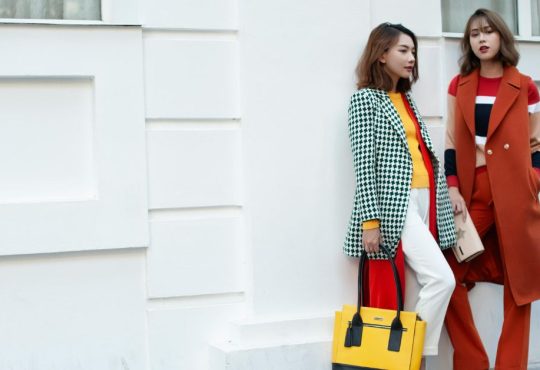
Fashion has long been a mirror of society, technology, and culture changes, and with 2025 in sight, the industry is on the verge of revolution. At the heart of the revolution is sustainability because growing environmental concern compels fashion businesses to adopt greener practices. More recycled materials, bio-fabrics, and plant-based innovations like mushroom leather and bamboo are becoming widespread, marking a shift toward more sustainable and green production techniques.
Along with sustainability, technology’s impact on fashion is also increasing. Innovations like smart clothing, which have technologies such as temperature control and in-built health-tracking sensors, have become more mainstream than ever before. Digital fashion shows and virtual platforms are also transforming the consumption of fashion, with waste being reduced but offering a more immersive, bespoke shopping experience for consumers. Moreover, AI is also being used for style trend forecasting and customized fashion design, as well as for automating the production process.
Inclusivity is another pervasive theme, and customers are demanding more diverse, body-positive, and gender-neutral fashion. The 2025 fashion will be about embracing a wide variety of body types, gender expressions, and cultural backgrounds so that everyone can wear clothes that reflect their individuality. In this new world, technology, sustainability, and inclusivity will come together to redefine the future of fashion.
The Big Predictions for 2025 Style Trends
The fashion industry in 2025 will be a blend of innovation and heritage, with sustainability being the key. The brands will be required to adopt green processes, materials, and production methods, aiming to reduce the environmental footprint of the sector. This trend is anticipated to include the use of recycled content at a mass level, bio-based materials, and alternatives like mushroom leather and bamboo fibers. Along with these sustainability initiatives, technology will continue to redefine the industry, enabling new design, production, and consumer engagement.
Cultural shifts will also determine the destiny of fashion. As consumers are increasingly demanding diverse, customized, and universal clothing, designers will evolve by creating garments that celebrate diversity and address a broader spectrum of body forms, gender identifications, and cultural heritages. Fashion will not just be a work of art but will also reflect the values of sustainability, technology integration, and diversity in this new era.
What Fashion Will Be in 2025
Colors and Patterns
The color story 2025 will be one of hope, vitality, and deep harmony with nature. Digital pastels, which reimagine soft hues for the digital age, will be prominent, bringing calm while pushing the boundaries of futuristic fashion. Along with these soft tones, bold neon colors will add energy and dynamism to wardrobes. Electric green, brilliant pink, and deep orange will be the overall colors of streetwear, informal wear, and nightwear, symbolizing energy and creativity.
Nature tones will also play an important role. Brown tones, including warm browns, terracotta, and forest greens, will appear frequently since they reflect the growing emphasis on environmental issues. These hues not only bring to mind the beauty of the natural world but also represent the transition to greener practices in the fashion industry. Ocean blues, pale greens, and rich yellows will emphasize the protection of the earth’s ecosystems so that fashion is compatible with eco-friendliness.
Geometric patterns, abstract designs, and asymmetrical cuts will also be extremely prevalent, offering a fresh and dynamic option to the more organic color palette. These designs allow individuals to express themselves and be original, avoiding conformity and embracing individuality.
Fabrics and Materials
By 2025, sustainability will change fabric choice fundamentally. The fashion world will embrace recycled materials, bio-fabrics, and plant-based alternatives. Recycled textiles, such as polyester made from post-consumer plastic bottles, will be the norm. Bio-based textiles, including mushroom leather made from the root structure of mushrooms and textiles made from bamboo, will see increased usage. These textiles carry the double benefit of conserving waste and giving superior textures and durability. As style moves away from man-made fibers, natural fibers such as hemp, organic cotton, and linen will become more popular since they have minimal environmental impact.
The use of technology in textiles will continue to expand. Fashion with smart capabilities will become mainstream, with clothing that can regulate body temperature, offer antimicrobial capabilities, or even monitor health metrics through embedded sensors. These tech-infused textiles will not only meet the growing demand for functionality but also be designed with aesthetics in mind so that the fashion-conscious can have their cake and eat it, too.
Silhouettes and Shapes
Loose-fitting garments will dominate the fashion scene in 2025. Relaxed, loose, androgynous cuts will become increasingly popular, demonstrating a shift toward a more relaxed, flexible, and accommodating fashion. These fashion trends will accommodate a broad range of personal styles and body types, enabling individuals to feel free and fluid in their fashion.
Other than oversized and unisex fashions, retro cuts will be an influential return. Classic cuts and designs of yesteryears will be revisited with a modern twist. This can come in the form of the return of 90s streetwear or 80s powerwear, but this time with a contemporary twist regarding fabric choice and construction. Retro-inspired fashion will be combined with sci-fi trends, creating a new vocabulary in clothing that marries past and future.
Fashion Style Trends in 2025
Casual Wear
The casual wear market will sync with the era, with athleisure fashion becoming more elegant. The rise of “at luxury” trends will render sportswear hard to separate from luxury fashion. Luxury materials like silk, cashmere, and high-end wool will be paired with traditionally casual wear like hoodies, sweatpants, and tracksuits. This trend will involve comfort and luxury existing together so that people can dress down without compromising style or sophistication.
Loungewear will be an everyday wardrobe item that emphasizes comfort but incorporates chic, refined elements to make it appropriate for both in-home relaxation and outside excursions. The fusion of functionality and high-end materials will make casual wear an essential part of any fashion-forward wardrobe, bridging the gap between leisure and luxury.
Formal Wear
The idea of formal wear in 2025 will defy traditional parameters. Traditional suits will be redesigned with bolder cuts, innovative textures, and unconventional colors to make the once-staid and uniform category a forum for uniqueness. Evening wear will also be so, with green fabrics and timeless styles that ensure longevity. Apart from sustainability, versatility will also be emphasized with a mix-and-match approach to pieces for use on multiple occasions, ranging from high-profile events to low-key occasions. This new emphasis on sustainable, long-term pieces will revolutionize how consumers perceive and spend on formal attire. The ability to personalize formal wear will provide a new level of self-expression and creativity, making every formal event a unique experience.
Streetwear
Streetwear will remain a dominant force in fashion. But by 2025, the style will balance retro influences and sci-fi designs. Graphic prints in bold colors, statement typography, and personalized embellishments will remain at the center of streetwear’s appeal, with the attire providing the freedom for individuals to make their statements. Sustainability will also be a significant part of streetwear, with brands gravitating towards more eco-friendly means of production and recycled or organic materials. The intersection of fashion and technology will lead to innovative designs that push the boundaries of traditional streetwear, making it a versatile and influential segment of the fashion industry.
The Role of Technology in Fashion
The intersection of fashion and technology will intensify. Fashion will become increasingly digital, with digital wardrobes and virtual fashion shows going mainstream. These technologies will make waste from traditional fashion shows a thing of the past and make high fashion more affordable for the masses. Virtual reality (VR) and augmented reality (AR) will allow consumers to try clothes virtually, eliminating the need for physical fitting rooms and reducing the carbon footprint associated with shipping and returns. Shopping driven by AI will also be tailored, offering recommendations in styles, colors, and sizes based on a person’s history and past purchases.
Why Fashion Trends Change
Fashion trends are influenced by various factors like cultural evolution, social revolution, and technology. Social networking sites like Instagram and TikTok will continue to influence global fashion trends as influencers and brands popularize fresh fashions among tens of millions of users. Pop culture, like music, films, and art, will continue to motivate designers and buyers forever.
The growing awareness of environmental issues has directly influenced the fashion industry as consumers and businesses have come together to make sustainability a part of fashion. Ethically sourced labor practices, sustainable production processes, and reduced wastage have become unavoidable necessities in the industry. Moreover, body-positivity, diversity, and inclusion movements have forced designers to redefine traditional notions of beauty, resulting in a more universal and inclusive approach toward fashion.
The New Era of Fashion in 2025
The 2025 fashion is experiencing a revolutionary transformation, combining sustainability, technology, and inclusivity into a more purposeful and useful business. Eco-friendly materials such as recycled fabrics and bio-fabrics are being adopted by designers, while technology provides smart wearables with health-tracking sensors and climate control. Inclusivity is widening with gender-neutral fashion and greater size ranges, making fashion more inclusive and diverse. Fashion is more than mere beauty; it is becoming a means of self-expression, self-assurance, and sustainability, connecting style to inner values and ecological responsibility.






